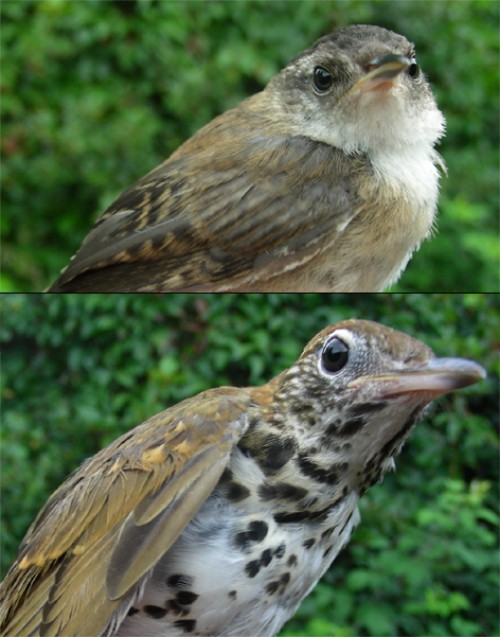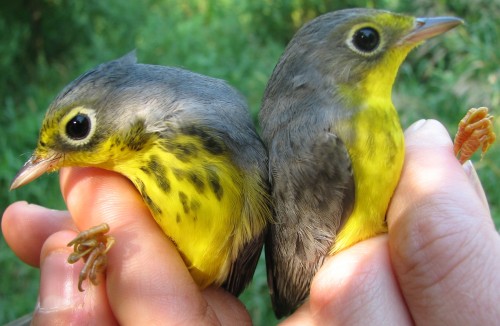|
Week 2: August 8-14, 2007 |
Welcome
to the McGill Bird Observatory weekly report.
Click here for a complete listing of our archives.
Comments or
questions are welcome at "mbo AT migrationresearch.org".
|
PICTURE
OF THE WEEK: |
|

This week’s superstars: two out of the three
new species banded this week for the first
time at MBO. The third species had to unfortunately be
omitted from this collage due to
technological difficulties in extracting photos from a cell
phone (note: always keep fresh
AA batteries on site), and so might appear in next week’s
update. Can you guess
what they are? See the text below for the answer.
(Photos by Marie-Anne Hudson)
|
|
|
THIS WEEK |
THIS FALL |
2007 TOTAL |
SITE TOTAL |
|
# birds (and species) banded |
142 (33) |
352 (36) |
1136 (70) |
10454 (101) |
|
# birds (and species) repeat |
50 (14) |
81 (19) |
196 (29) |
1745 (56) |
|
# birds (and species) return |
6 (5) |
16 (7) |
101 (23) |
301 (28) |
|
# species observed
|
73 |
84 |
142 |
187 |
|
# net hours |
462 |
832 |
3331.75 |
17354.5 |
|
# birds banded / 100 net hours |
31 |
42 |
34.0 |
60.2 |
|
|
Note: table does not include nocturnal banding (owls) |
|
Banders-in-charge: Marie-Anne
Hudson, Barbara Frei
Assistants: Sophie Cauchon, Shawn Craik, Jean Demers, Emily Gray,
Gay Gruner, Francine Marcoux, Sarah Marteinson, Chris Murphy, André
Pelletier, Greg Rand, Daniel Schmucker, Clémence Soulard, Rodger Titman
Notes:
This week certainly started off with a bang – not in terms of the
numbers of birds banded, but certainly in terms of the species. Within
the first round on Wednesday, two new species were banded for the first
time at MBO since its inception in 2004: a hatch-year Wood Thrush and a
very pale hatch-year Marsh Wren, pictured above. To make matters even
more exciting, a third species was added the very next day! A young
male Cooper’s Hawk was found floundering in net D2, next to a Baltimore
Oriole that looked none too pleased. Happily, both birds were perfectly
fine and, once banded, measured and photographed, were raring to go.
Other
new species banded this week were: Yellow-shafted Flicker (netted again
later in the week), Philadelphia Vireo, Tennessee Warbler, Least
Flycatcher, and Canada Warbler. Not to be outdone by the new species
banded, we also observed tons of new species for this season: Great
Horned Owl, American Bittern, Least Sandpiper, Northern Goshawk, Yellow-rumped
Warbler, Hermit Thrush, Herring Gull, Red-shouldered Hawk, Lincoln’s
Sparrow, Common Loon, Great Blue Heron, Ring-billed Gull (finally!),
Rock Pigeon, and House Sparrow. A few of these were particularly
noteworthy. The Hermit Thrush was exceptionally early, with the
first individual in 2005 not seen until September 25, and in 2006 until
September 30; likewise the Lincoln's Sparrow is a record early arrival,
with the previous record being August 30 in 2006. We're hoping
these birds aren't an advance warning of an early winter! Also
worth special mention is the Least Sandpiper, never before seen at MBO,
becoming species #187 on our ever-growing
checklist. These exceptional birds made for welcome excitement
during an otherwise slow week – last year during week 2 we banded 225
birds.
This
week’s top ten species banded is quite different from last week’s top
ten. Five species have been added, and some are quite unusual for MBO:
Traill’s Flycatchers and American Redstarts aren’t usually anywhere near
the top of our weekly lists. This is likely due to both an influx of
migrants and young dispersing from their natal site. The latter is
especially true for Gray Catbirds and Downy Woodpeckers, as almost all
have been hatch-year birds, some even juveniles. Imagine Barbara’s
surprise when she arrived at C2 to find five extremely vocal Downy
Woodpeckers all together, eager to escape and peck. Song Sparrows,
though less than half than last week’s number (and barely one quarter as
many as during this week last year), continued to dominate this week.
As always, August is full of surprises, which makes it ever-interesting
to compare this week to last year at this time: Baltimore Orioles, quite
scarce at the moment, were in second position behind the Song Sparrow,
and just ahead of the Rose-breasted Grosbeak. It just goes to show how
different things can be from year to year - and why it is important to
have several years of standardized data collection before assessing
population trends.
|
This week’s
top 10
[last week’s rank in brackets]
|
#
individuals banded |
mean # individuals observed daily |
|
1.
Song Sparrow (20)
[1] |
1.
American Crow (26)
[7] |
|
2.
American Redstart (15)
[7] |
2.
American Goldfinch (23)
[3] |
|
3.
Traill’s Flycatcher (10)
[-] |
3.
Cedar Waxwing (18)
[6] |
|
4.
Downy Woodpecker (9)
[-] |
4.
Song Sparrow (18)
[2] |
|
5.
Yellow Warbler (9)
[2] |
5.
American Robin (15)
[8] |
|
6.
Red-eyed Vireo (8)
[-] |
6.
Black-capped Chickadee (15)
[5] |
|
7.
Black-capped Chickadee (7)
[8] |
7.
Common Grackle (14)
[4] |
|
8.
Gray Catbird (7)
[-] |
8.
Red-winged Blackbird (11)
[1] |
|
9.
Cedar Waxwing (5)
[10] |
9.
Ring-billed Gull (7)
[-] |
|
10.
Common Yellowthroat (5)
[10]
10. Nashville Warbler (5) [9] |
10.
Gray Catbird (6)
[-] |
|
This
week’s top ten species observed is similar to last week’s, with a few
changes, as usual – nothing ever stays the same! Funnily enough,
Ring-billed Gulls first appeared on the first day of the week, and
quickly increased in number to appear on the top ten, albeit in 9th
place. Red-winged Blackbirds, topping the list last week and in second
position last year at this time, are way down the list in 8th
place. We’re just waiting for the immense clouds of blackbirds (mainly
Common Grackles and Red-winged Blackbirds) to reappear, as they did last
year. We’re also waiting for the warblers to descend upon us, which
should be any day now if these little guys are the front-runners…
|

These two young Canada Warblers graced our nets at the same
time, enabling us to get a great comparative shot of the two,
the male on the left, the female on the right. (Photo by Barbara
Frei)
|


